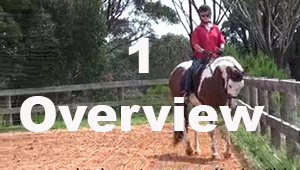
Hindquarter Contol - Overview
This series of lessons will teach your horse independent hindquarter control from the rein. This will lead you to travers (haunches in), collection, lateral work, canter leads and flying changes, just to name a few!
Training Information
Suitable For: All horses can do the ground work lessons and those under saddle can continue.
Videos in Course: 7
This course will give you independent hindquarter control off the reins, leading to travers (haunches in) for collection, canter leads and flying changes.
Purpose:
The purpose of this lesson is to teach your horse independent control of the hindquarters off the rein. This means engaging the hindquarters without moving the horse's shoulders and without the rider having to apply leg pressure.
Some of the many advantages of teaching this on the rein, as opposed to the traditional leg cue, are that the horse remains more relaxed, better able to elevate his shoulders, stretch through the outside barrel and it leaves the rider's leg aids free for more advanced lateral work.
The Basic Lesson Elements:
The SPOT on the horse that you want to move: The left hind leg
The DIRECTION you want it to go: To the left
The MOTIVATION for moving it: Bit pressure from the right rein
The REWARD given for the correct response: Release of pressure, and praise the horse
Prerequisites:
- Give to the Bit - travel in frame and softness in the bridle
- Shoulder Control - same-rein-same-foot and reverse arc
ISES Training Principles:
- Release the pressure immediately when the horse responds. Your job is to mentally connect the rein to moving the hind leg so as soon as you see (and later feel) the leg move, immediately release the rein pressure.
- Use signals that the horse can differentiate. Teaching the rein signal by moving the rein in a different direction than when signaling the horse to turn makes it easier for the horse to distinguish the new cue.
- Train and initiate responses one at a time (shaping). We begin the lesson by disengaging the right hindquarter and shape this behaviour so that by the end of the same lesson we have engagement on the left side.
- Train habitual responses using consistency and repetition.The horse is learning the pattern so we must be consistent with the release of pressure on each repetition until the lesson has been learned.
- Train only one response per signal. By the end of the lesson, our signal will be raising the outside rein to engage the inside hind leg.
- Avoid fear during training. Horses often become fearful of the leg when being taught hindquarter control. We are not using leg here but be careful not to surprise the horse when picking up the rein pressure. If you pick it up slowly it gives the horse a chance to respond with the desired movement before he feels any pressure - exactly what we are aiming for.
- Train persistence of responses. We want the horse to maintain the movement until we signal him to do something else. At the end of this lesson the horse should stay in travers until signaled to straighten.
- Check for relaxation. Relaxation always improves learning and performance. If your horse is throwing his head, pulling on the reins or rushing then he is not relaxed and this is a clear indication that you have gone too far too fast.
